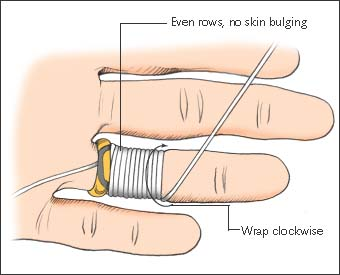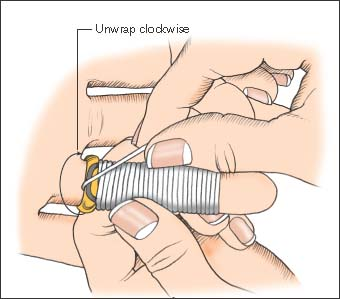Ring Removal
A ring can become excessively tight on a patient’s finger after an injury such as a sprain or from some other cause of swelling such as the swelling that can occur in a localized allergic reaction. Very tight-fitting rings can obstruct lymphatic drainage, causing swelling and further constriction. Removal may be necessary to relieve chronic or acute edema and to prevent vascular compromise in a finger or toe constricted by a ring or metal or plastic band.
Equipment
Ice ▪ soap and water ▪ towel ▪ lubricant (petroleum jelly, lotion) ▪ rubber tourniquet or Penrose drain ▪ Optional: local anesthetic without epinephrine, syringe, needles, alcohol pads.
Coiled-String Method
String, umbilical tape, ribbon gauze, or thick suture material.
Ring-Cutter Method
Lubricant (some cutters require a water-soluble lubricant) ▪ ring cutter (manual, battery, or electric-powered) ▪ pliers, hemostat, or ring spreader ▪ protective eyewear ▪ 20-mL syringe filled with water.
Implementation
Confirm the patient’s identity using at least two patient identifiers according to your facility’s policy.4
Explain the procedure to the patient. Answer all questions to decrease anxiety and increase cooperation.
Inspect the digit for wounds, lacerations, fractures, or dislocations. Assess the digit’s capillary refill, sensation, and movement.
Nursing Alert
If vascular compromise is present, the ring should be removed with a ring cutter as quickly as possible.
Assess the patient’s pain level.
Obtain an X-ray of the digit, if ordered, and report abnormal findings to the doctor.
To limit further swelling, apply ice and elevate the affected extremity above heart level. You can also wrap a rubber tourniquet or Penrose drain circumferentially in a distal-to-proximal direction to reduce swelling. Leave the wrap in place for 5 minutes, and then remove it.
Lubricate the skin beneath the ring with soap and water or a lubricant to allow the ring to be slipped off of the finger or toe. Hold the ring with a towel, and pull with a rocking motion in an attempt to remove the ring.
Nursing Alert
Even if the patient tells you he has tried to remove the object from the finger at home, it’s generally worthwhile to attempt removal with soap and water or a lubricant before trying other techniques. The pain from constriction often prevents the patient from applying adequate circular traction to remove the ring.
If the ring can’t be removed, use one of the methods below.
Coiled-String Method
Nursing Alert
Don’t use the coiled-string method if the patient has any lacerations, fractures, or dislocations involving the affected digit; use a ring cutter instead.
While the affected digit is elevated, slip the end of a long strip of string under the ring. Use a hemostat, if necessary, to thread the string under the ring.
Anchor the string with your nondominant hand, or ask the patient to anchor it.
Wrap the string around the digit, beginning adjacent to the ring margin. Wrap the string in a snug, smooth, single layer in a clockwise fashion, slightly overlapping the previous layer, progressing from proximal to distal until it covers the area of greatest swelling. Because the area of the proximal interphalangeal joint is the most difficult area to slip the ring over, make sure that you wrap this area firmly (as shown below).

When the wrapping is complete, pull the proximal end of the string against the ring and then start to unwrap the string in a clockwise direction, moving the ring toward the tip of the finger (as shown below). If needed, place a small amount of lubricant over the string to facilitate sliding the ring.
 |
Get Clinical Tree app for offline access



